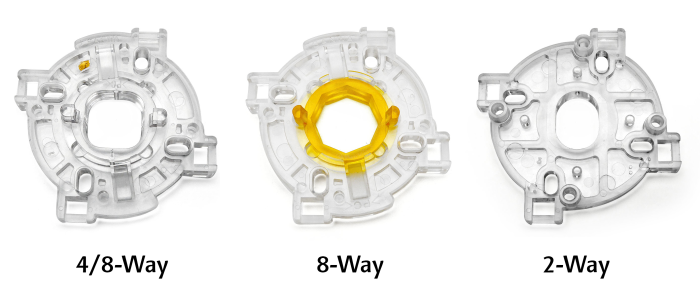In my time in the FGC, I’ve noticed two extremely common misconceptions, about Korean joysticks in particular. It doesn’t really come as a surprise that people aren’t so well-informed about Korean joysticks considering their usage in the West, or lack thereof. What does surprise me though, is that there seems to be quite a few people out there who are irredeemably uninformed and yet readily and confidently offer their extremely welcome, sagely advice despite being utterly incorrect. Hopefully this blog post will be useful in preventing this misinformation from spreading.

Misconception 1: Korean joysticks have a round gate.
Pictured above are two joysticks. On the right is the Sanwa JLF, the AK-47 of Japanese joysticks. It’s been through several revisions and is the tried and tested weapon of choice for many Japanese, and even Western players. Almost every fighting game arcade cabinet in Japan is equipped with one of these, and if you paid good money for your arcade controller, chances are you’ve also got one as well.
The Korean counterpart to the JLF could arguably be the Myoungshin Fanta, but alas the lever on the left is the even more OG Taeyoung Fanta. According to Etokki, the “Taeyoung Fanta stick is the original Fanta stick that started the whole Korean stick craze.” Needless to say, it’s a worthy standard to judge Korean levers by. Let’s take a look at the undersides.

Look closely at the JLF. Or don’t, you’ll still see it. There’s a clear piece of plastic attached to the bottom of the joystick – this is the restrictor gate. As the name implies, it restricts the movement of the joystick. The actuator of the joystick is bounded by the square-shaped opening in the restrictor gate, which is the limit of its motion. If you move the joystick around, you’ll be able to feel that the square shape is quite distinct.
Now over to the Taeyoung. Its restrictor gate is… non-existent. That’s right, Korean joysticks (typically) have no restrictor gate. Restrictor gates are almost exclusively a Japanese joystick feature. The reason Korean joysticks allow circular movement is because the shafts are on a pivot, which gives you the full range of motion simply by virtue of being a pivot. The movement isn’t restricted by a circular restrictor gate, it’s just naturally circular. This is also true for Japanese joysticks – if you remove the restrictor gate, it would also be able to move circularly.
That being said, most Korean sticks have a collar, which can be seen clearly in the first picture. This also affects the kind of movement that the joystick can make. It happens to be a circle as well, which in part means that the joystick motion as a whole is circular. However unlike restrictor gates which act like a guide of sorts, the collar of a Korean lever is simply a physical limit and isn’t really intended to determine the range of motion. It isn’t an equivalent. Korean sticks do not have a restrictor gate, and more importantly, “gate” does not mean the shape of the movement.
Aside: Restrictor gates.

While we’re on the topic of restrictor gates, there’s also an irksome misnomer I’d like to clarify as well. There are a variety of differently shaped restrictor gates available which can drastically change how a Japanese joystick feels. You may have heard of them referred to as 4-gates or 8-gates—this is wrong. A joystick only ever has one restrictor gate. Just imagine having 4 or 8, it doesn’t even make sense to think about.
Hopefully this doesn’t come as a surprise, but there are actually names for polygons in English. “Square” and “octagon” are the ones that immediately spring to mind, for starters. Indeed, the correct way to differentiate restrictor gates is by indicating the shape of the restrictor. Square gate, octagonal gate, whatever you like.
Another property of restrictor gates is the number of directions they allow. This is likely the root of the 4-gate/8-gate business, so I’ll make it crystal clear. An octagonal gate allows 8 directions—up, down, left, right and the diagonals—hence, 8-way (not 8-gate). Now you might be thinking “Hold on Blank, I can move in 8 directions on my square gate too!”, and you’re exactly right. A square gate is also an 8-way restrictor gate. This is exactly why you can’t distinguish restrictor gates by the number of directions they allow. They aren’t unique.
Before someone cries “But a 4-gate means the shape has 4 sides!”, I’ll clear that up too. If saying “square” is too challenging, you’re going to have to practice because a square gate can also be 4-way. There’s a shape quite similar to a square that can achieve this – a diamond. A square gate can be rotated 45° to make a diamond, which will prevent diagonal inputs on your joystick. This is why a square gate can be both 4-way and 8-way, and another reason why you should refer to restrictor gates by their shape. Don’t be ambiguous.
Anyway, back on topic.

Misconception 2: Balltop = Japanese, Battop = Korean.
When a bright, aspiring joystick enthusiast attempts to begin his journey by asking “What’s the difference between a Japanese stick and a Korean stick?”, his innocent mind is immediately tainted with false information by some ignorant FGCer with a false sense of authority who somehow happens to always be the first to reply “Japanese sticks are balltops, Korean sticks are battops”. If you look at the picture above, you can see that the Korean Crown 303 does indeed have a battop handle and the Japanese Sanwa JLF has a balltop handle. So what’s wrong with that?

See, if I swap the handles on the two joysticks, the Korean stick now has a balltop and the Japanese stick now has a battop. Neither stick had a nationality crisis or change of visa—the 303 is still a Korean stick and the JLF is still a Japanese stick. Changing the handle is trivial and almost inconsequential in how it affects the feel of the joystick. Although Korean joysticks usually come with battop handles and Japanese joysticks usually come with balltop handles, Korean ↔ Battop and Japanese ↔ Balltop are not interchangeable.
The shape of the handle of a joystick determines whether it’s a Japanese stick or a Korean stick as much as the colour of your shoes determines their brand (read: it doesn’t). Needless to say, battop and balltop don’t serve as classifications of joysticks either. You can’t generalize sticks into either battop or balltop because the exact same stick can have a battop or balltop handle. You can, however, classify them as either Japanese or Korean (or otherwise) because there are actual non-trivial differences between them.

At a glance, there are quite a number of differences between the inner mechanisms of each joystick. These are all very important in affecting how the joysticks feel (much more so than the shape of the handle, I might add) and it’s this that determines what type of joystick you have. The most notable of these is the tension, which can easily tell you whether you have a Japanese or Korean joystick.
The tension of a joystick is the mechanism that controls how it returns back to neutral, and by extension, how it feels when you move it away from neutral. On the JLF, you can see a spring on the shaft. This is the tension mechanism for Japanese sticks. The spring is stretched when you move the lever towards a direction, and then pulls the lever back to neutral when you let go.
On the other hand, Korean joysticks employ no such spring. If you look at the disassembled Taeyoung, there isn’t a spring in sight. Korean sticks are tensioned by rubber or silicone grommets, which is the clover-shaped thing inside the housing. This is stretched and compressed when you move the lever and snaps the joystick back to neutral when you let go.
I could go on about all of the other intricacies, but I would digress and end up shilling Korean levers, so we’ll keep it at that. This was the most important thing anyway. To reiterate: Balltops are not Japanese sticks and battops are not Korean sticks. Japanese sticks have spring tension and Korean sticks have rubber/silicone tension.

Joysticks are pretty cool. If you liked what you just read, check out the Slagcoin article. If you didn’t really care, at least you know the truth now, so you can be the asshole that corrects people on the internet when this gets mentioned. That would make me pretty happy.